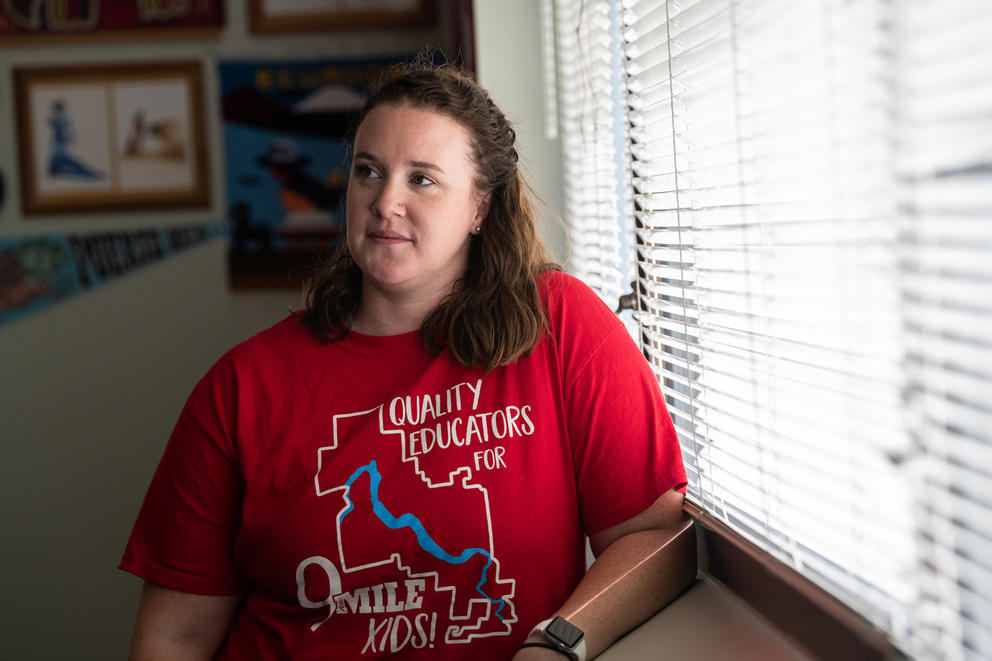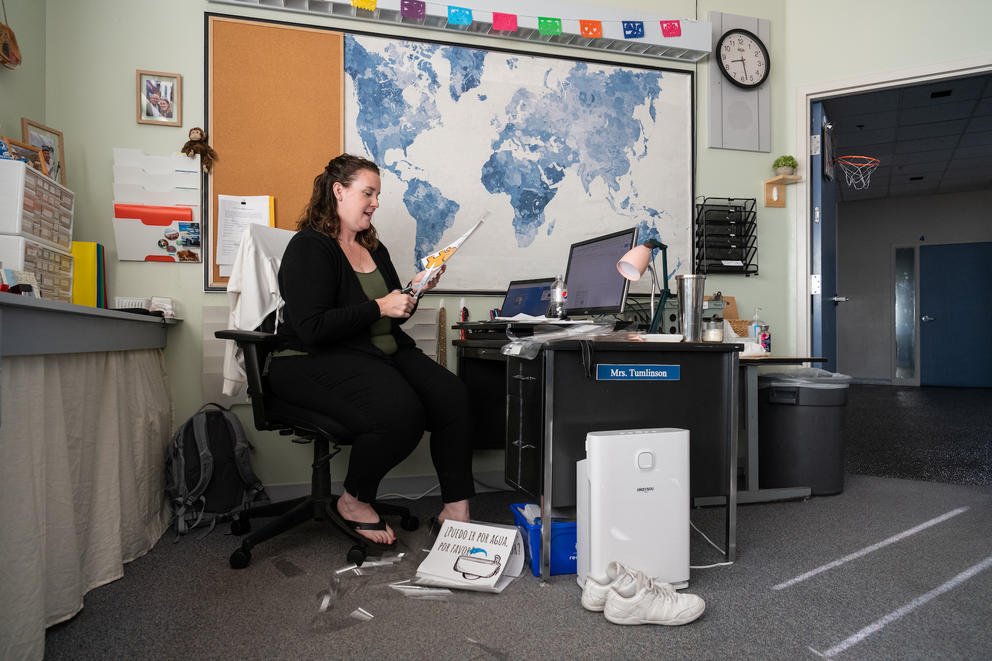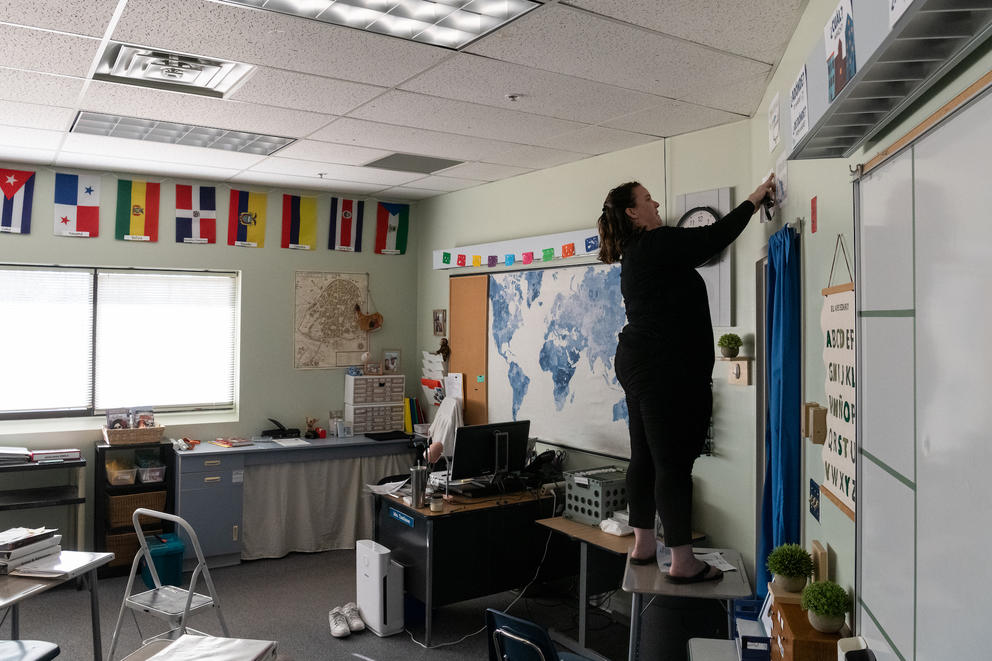Joaquín Rodríguez, who is going into his third year of teaching, remembers last year as a juggling act between his regular duties, filling in for absent colleagues during his prep periods and offering extra support to students wrestling with pandemic-related trauma.
“Hopefully we'll never see something as challenging as that again,” said Rodríguez, a multilingual science teacher at Franklin High School in Seattle.
InvestigateWest (invw.org) is an independent news nonprofit dedicated to investigative journalism in the Pacific Northwest. Visit invw.org/newsletters to sign up for weekly updates.
This year isn’t expected to be much better. Many educators and administrators across the Pacific Northwest are bracing for only slightly abated staffing challenges as they return to campuses in August and early September.
“When I come into this next year, my worry is that if we can’t find a way to really address these issues in a meaningful way and meet the needs of our community, many educators … are going to be looking for elsewhere to work,” Rodríguez said.
Officials from both large urban school districts and rural districts in the region report ongoing challenges hiring a variety of essential staff, from bus drivers to special education teachers.
In the Hillsboro School District west of Portland, Oregon’s fourth-largest school district, bus drivers and classified staff such as custodians are most in demand, officials said.
This month, the district was seeking to fill nearly 50 bus driver vacancies — about 25% of the necessary workforce.
By contrast, teacher vacancies five weeks before the school year were in fact “not too bad,” said Beth Graser, Hillsboro district spokesperson. Only 20 teaching positions were unfilled — about 2% of approximately 1,230 licensed positions in the district.
But hiring for those positions now is also more challenging.
“In the spring, the applicant pool is much deeper — we would get anywhere from five to 50 applications for each position,” Graser said by email. “At this point, the pool is much shallower with only a handful of people applying.”
Staffing problems drove headlines during the last school year. At the time, district officials sought the help of legislators and sweetened their offers, from hiring and retention bonuses to increased benefits and pay.
Meanwhile, researchers studying the education labor market stress the importance of determining precisely where the needs are greatest and which barriers stand in the way of districts hiring and retaining employees.
“These are problems that, if we talk about it in a very generic way, I don’t know if policymakers end up implementing solutions that kind of move the ball forward,” said researcher Dan Goldhaber, director of the Center for Education Data and Research at the University of Washington. He is an author of a 2021 report that analyzed job postings from 216 Washington school districts to establish a real-time snapshot of which positions were going unfilled most frequently.
His research showed special education teachers, English language teachers, coaches and paraprofessionals, who are classified employees who assist students in the classroom, made up the majority of staff that schools were struggling to hire. Those trends, which were broadly true even before the pandemic, likely persist this year, Goldhaber said.
Since Oregon, Washington and Idaho all lack comprehensive, real-time data on school districts’ hiring needs, the states have largely pursued more broad-brush solutions, such as additional funding schools can use in a variety of ways.
Oregon state Sen. Michael Dembrow, D-Portland, who chairs the Senate Committee on Education, said a workgroup first convened in 2021 is still looking at midrange and long-term solutions, including ways to implement robust data collection.
“I think what’s going to be important for us is to be able to move beyond anecdote and get a clear sense of what’s out there,” he said.
Ongoing Need for Subs
Caitlin Tumlinson, who teaches Spanish at Lakeside High School in the Nine Mile Falls School District northwest of Spokane, estimated she was asked to sub for absent colleagues during her prep period around 15 times in the last school year.
“In a 180-day school year, that’s a large percentage,” she said. But she wasn’t the only one stepping up outside of her normal duties. Classified staff who held bachelor’s degrees and the district’s chief financial officer became certified substitutes to help out.
About 15% to 20% of needed substitute positions were going unfilled on a typical day last year, according to data Tumlinson provided from the Nine Mile Falls District.
That’s similar to Hillsboro in Oregon, where about 20% of teacher absences were unable to be filled by a sub on an average day, Graser said.
Short- and long-term substitutes are still in high demand as the new school year begins.
New Jersey-based company Education Solution Services, which 21 Oregon school districts partner with, is looking to hire 2,500 substitutes statewide in addition to the 1,300 already on the books. The company is offering bonuses for referrals that lead to hires and bonuses tied to various lengths of service.
In Washington and Oregon, emergency certifications for full-time teachers and substitutes have allowed more people from local communities to step into the classroom and help. More than 1,100 emergency substitutes were hired in Oregon during the last school year, according to data from the Oregon Teacher Standards and Practices Commission that was first reported by the Oregon Capital Chronicle.
The emergency certifications have drawn criticism from some, since applicants weren’t required to have any teaching experience. And in Oregon, neither of the emergency certifications require a bachelor's degree. Its emergency substitute license was approved in 2021, just weeks after the school year began.
State leaders, Dembrow said, “came to realize what thin margins the schools were operating on. People had to be away because of COVID, and there were no reserves for them.”
Oregon earlier this year extended the emergency substitute certification option through the coming school year, recognizing that schools’ needs for substitutes has not abated in time for the coming year.
Michael Fuller, a Portland civil rights attorney who first got his emergency substitute certification this past spring, said he began the process in February after reading news stories about the impact of substitute shortages on students and full-time staff. It took him about a month to complete a background check, take the necessary trainings and be cleared to substitute
“It's been incredibly rewarding,” Fuller said. “It’s a very unique opportunity, and I think people would be impressed with the quality of students in Oregon schools right now.”
A Dearth of Data
During those strained initial months of last school year, Goldhaber’s research shed light on the fact that some positions were much more in demand than others.
Goldhaber, who is based in Seattle but conducts research across the nation, set out last fall to compile data that would show which types of employees — not just teachers — Washington schools were most in need of hiring.
His report, released in November 2021, showed that hiring needs varied with the size of the district and the poverty level in the community it serves.
Across all job categories, rural districts generally had a greater need for all staff compared to more urban districts. Higher-poverty districts also had more needs than lower-poverty school districts.
Notably, positions seeking classroom paraprofessionals were nearly double that of teacher postings statewide, Goldhaber observed.
Listings for special education teachers also vastly outpaced other specializations.
Goldhaber and his research colleagues wanted to draw out these insights on the education labor market in Washington because the state does not yet compile such data itself.
Media coverage of hiring challenges often deals with the shortage “as if it exists everywhere for all teachers and all schools, and that is not at all the way it is,” Goldhaber said. “It’s really clear there are much more extreme challenges to hiring teachers in certain specialty areas, such as STEM and special ed and [English-language learners], and that different kinds of districts and schools also have a much more challenging situation.”
It’s that sort of nuance, he said, that can help inform leaders’ search for solutions.
As an example, Goldhaber pointed to other states that have implemented pay incentives to hire more special education teachers, such as Hawaii, which began offering those teachers a $10,000 bump in their annual salary in 2020. A year later, the state’s special education vacancy rate had halved from 2019.
But more commonly, Goldhaber said, “a lot is being spent in generic ways and not targeting (specialties).”
State leaders in the Pacific Northwest expressed growing interest in such data to better tailor funding and support.
Washington’s Office of the Superintendent of Public Instruction, for example, is “working to improve our educator workforce supply and demand data systems so we can more accurately estimate teacher vacancies,” spokesperson Katy Payne said in an email.
In March, Oregon legislators tasked the Oregon Department of Education and the Teacher Standards and Practices Commission with creating a more streamlined job application database that will make it easier for educators to apply for jobs in multiple school districts at the same time. That could also increase the likelihood of collecting statewide data on school staff vacancies.
Relief on the Way
Still, school leaders pointed to bolstered state funding that should provide some relief.
In Oregon, that included a funding increase of $78 million that school districts can use to fund teacher recruitment and retention initiatives. They can also reimburse substitute teachers and paraprofessionals for past and future training costs through January 2024.
“I am really looking forward to seeing how those plans play out over the next few months to see which strategies we want to build on,” Dembrow said.
Idaho’s Legislature pushed more than $100 million into increased teacher salaries this year. And in a more targeted move, it passed a law to establish incentives for teachers to stay in rural or high-poverty schools. In the first year, 750 teachers could qualify for $1,500 each. The incentives will increase each year over four years.
Washington elected to provide schools with a 5.5% cost-of-living increase for all staff this spring. In some districts, that money will automatically be passed through to teachers. In other districts, unions and districts are bargaining over it.
The state Legislature also approved an increase to the per-student funding level for mental health professionals, which could enable districts to hire more psychologists and counselors. Based on current projections, it will cost the state around $114 million in the first year.
Julie Popper, Washington Education Association spokesperson, said bringing in more mental health professionals also helps retain teachers.
“A lot of our educators are saying that since the pandemic, more and more students are showing up with acute behavioral and mental health needs that get in the way of their learning,” Popper said. “Sometimes that can get in the way of learning for the whole classroom. So those services are really critical to educators being able to do the kind of teaching they need to do on the curriculum.”
Meanwhile, other positions remain stubbornly difficult for schools to staff. Bus drivers are one. And paraprofessionals, who are historically paid lower wages, are being drawn off to better-paying jobs in other fields.
But the picture isn’t all bleak. Tumlinson, the Spanish teacher in the Nine Mile Falls district, said she is heading into the new year feeling better rested after this summer than after the last two. And she’s less worried about the impact of changing COVID policies disrupting schedules.
“Personally, I am optimistic that this is going to be more normal in a way we haven't seen in the last couple of years,” Tumlinson said.
Rodríguez also said he feels some pressures have eased, but he’s more guarded about how this year could go.
“There’s definitely work we need to do to make sure there’s protection and corrections in our system,” he said. “That workload hasn’t necessarily gone away, and I don’t know if we have the ability to create more hours in a day, so we definitely need more hands.”
InvestigateWest (invw.org) is an independent news nonprofit dedicated to investigative journalism in the Pacific Northwest. Visit invw.org/newsletters to sign up for weekly updates.







